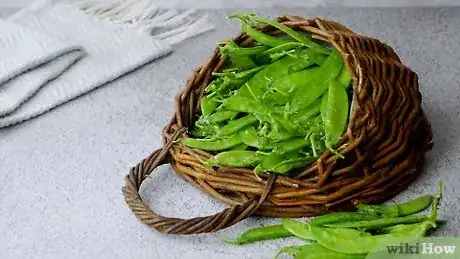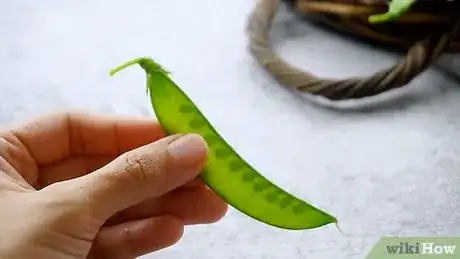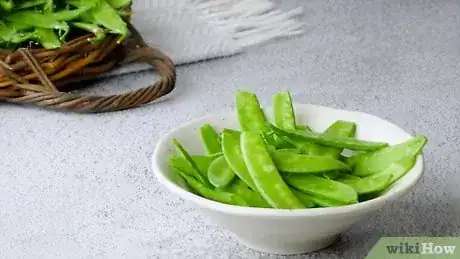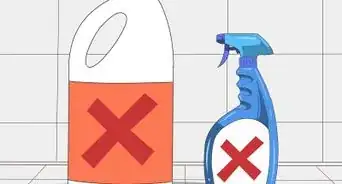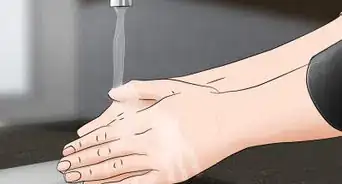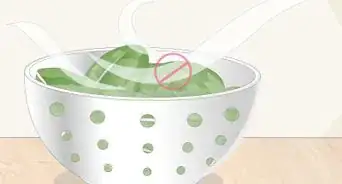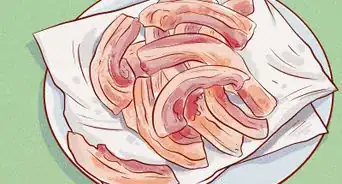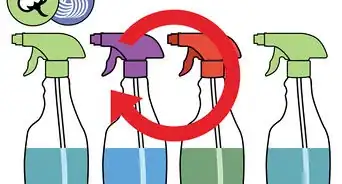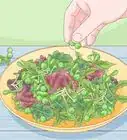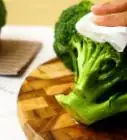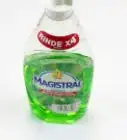This article was co-authored by wikiHow Staff. Our trained team of editors and researchers validate articles for accuracy and comprehensiveness. wikiHow's Content Management Team carefully monitors the work from our editorial staff to ensure that each article is backed by trusted research and meets our high quality standards.
There are 10 references cited in this article, which can be found at the bottom of the page.
The wikiHow Culinary Team also followed the article's instructions and verified that they work.
This article has been viewed 35,720 times.
Learn more...
Snap peas are a great snack or addition to any meal. They are the product of a mix of both garden and snow peas. To clean your snap peas, start by choosing fresh, unblemished pods. Give them a water or vinegar bath. Cut off the stem end with a sharp paring knife and remove the pod string. Wash once more and they are ready to go![1]
Steps
Selecting Your Peas
-
1Choose fresh, young peas. Select snap peas that appear firm, but not hard. If you place the pod up to your ear and shake just slightly, you should hear a little bit of rattling. This indicates that the peas are mature. Look for a consistent bright green color free of dark marks or blemishes.[2]
- If you choose pea pods that are too old, then you run the risk of a fibrous, chewy texture.
-
2Harvest them at the right time. IF you are taking your peas directly from the field, instead of buying them in a store, then you need to pick them at the perfect time to ensure the right texture and flavor. Aim to pick the pods before the temperature gets too warm. Make sure that you can process the peas immediately after picking.[3]
- To remove the peas, place your fingers at the spot where the stem meets the pod and gently apply pressure. This should snap the pod off while keeping the vine intact.
Advertisement -
3Examine for any blemishes. Before you begin the cleaning process, sift through the pea pods with your hands and inspect each one for any markings or cuts. Discard those pods that have obvious blemishes or cuts that go through the pod and into the interior.[4]
- If you are hesitant to simply throw away damaged pods, you can sometimes cut off the bad portions with a sharp knife, after following the cleaning process.
Trimming and Washing Your Peas
-
1Place the pods into a strainer. Empty all of your pods into a strainer with small holes or slits in the side. Make sure that none of the pods can slip through these gaps. If you have too many pods, then you may need to do the rinsing process in a few separate loads.
-
2Wash your hands. Take a moment to run your hands under warm water. Scrub them with soap and then dry them thoroughly. This will prevent any bacteria from your hands from coming into contact with your freshly cleaned pea pods.
-
3Rinse the pods off. Turn on your tap water and place the strainer under the stream. Gently move the strainer around and use your free hand to move the pods. Try to get water on every pod. Continue to rinse for a few minutes until you no longer see dirt or debris on the pods.
-
4Spray them with a vegetable cleaner. These sprays serve the same purpose as a water bath, but are supposed to add an extra layer of protection against dangerous pesticides and bacteria. Follow the directions on the bottle carefully when using.
- Doing a thorough cleaning is especially important as some types of snap peas have been placed within the pesticide-laden “Dirty Dozen.”[5]
-
5Set the pods aside. Place the strainer onto a plate. This will allow the water to continue to run off the pea pods as you choose them for cutting and shelling. There is no need to do anything but air dry them at this point.
-
6Remove the ends of each pod. Choose a single pod. Use either a sharp knife or your fingers to remove the end of the pod that connected to the stem. Cut it through or apply enough pressure so that it snaps away. You do not need to trim the other end, although you may choose to do so.[6]
- A sharp paring knife is generally the best tool to use, if any, for this task. Make sure to go slowly as the pods can be a bit slippery post-washing.
-
7Remove the strings. After you cut the end off the pod, you might notice a tough string. This string is fairly thick and travels down the length of the pod. Grasp this string with your fingers or pin it against the knife and pull. It should slide out of the pod fairly easily.[7]
- Be aware that some stores sell prepackaged stringless snap peas. This means that you can wash them and then eat them immediately, skipping the cutting stages.[8]
-
8Place the cut pods in a new bowl. As you finish each pod, set it into a new bowl or strainer. When you are finished with the trimming, give the whole group of pods another quick wash under the water.[9]
-
9Dry thoroughly. You can set the pods out to dry on a fresh, clean towel. Or, you can pat them dry one-by-one with a paper towel. Either way, it is important to get them completely dry, especially if you plan to freeze them, as any water will turn into ice crystals.[10]
-
10Soak them in a vinegar solution. If you want an extra layer of protection against chemicals, you can place your pods into a vinegar solution prior to cutting. Make a solution comprised of 90% distilled water to 10% vinegar. Let your peas sit for 15-20 minutes before removing them.[11]
- However, be aware that is has been shown that a cold water rinse can remove between 70-80% of pesticides from most produce.
Using Your Peas
-
1Eat or prepare as soon as possible. As soon as you finish the cleaning process, decide immediately whether to store or eat your peas. You can store your peas for up to 4 days in a container with some air circulation in a refrigerator.[12]
-
2Eat them raw. Once your peas are cleaned you can eat them straight away as-is. They will have a crunchy texture that goes well on top of salads or as a quick snack.[13]
-
3Boil the pods for stock. If you choose to remove the peas from the pods, then you can place the pods in some boiling water to create pea-flavored stock. This stock can then be used to add flavor to rice and other dishes.[14]
-
4Blanch the pods. Boil the pods, with the peas inside, in water for 5 minutes or so. Add a dash of salt to the water mid-boil. Remove the pods, drain them, and place them immediately in a bowl with cold water.[15]
-
5Saute them. Throw some pods into a saucepan with olive oil and garlic. Add any other vegetables and continue stirring until everything is cooked through. The pods should be cooked after about 5 minutes on medium heat. Remove and eat.[16]
Warnings
- Do not let your washed peas contact any unwashed produce or they could be contaminated with potentially harmful bacteria.⧼thumbs_response⧽
Things You’ll Need=
- Snap peas
- Water
- Strainer
- Towel or paper towels
- Paring knife
- Vegetable cleaner (optional)
- Vinegar (optional)
References
- ↑ http://www.thekitchn.com/whats-the-difference-between-snow-peas-sugar-snap-peas-and-english-peas-ingredient-intelligence-205118
- ↑ https://food52.com/blog/3897-down-dirty-shelling-peas-snow-peas-snap-peas
- ↑ https://bonnieplants.com/growing/growing-green-peas/
- ↑ http://www.recipetips.com/kitchen-tips/t--1141/all-about-peas.asp
- ↑ https://www.mindbodygreen.com/0-17624/12-fruits-veggies-with-the-most-pesticides-2015-dirty-dozen.html
- ↑ http://www.recipetips.com/kitchen-tips/t--1141/all-about-peas.asp
- ↑ https://www.realsimple.com/food-recipes/easiest-ways-to-trim-produce/how-to-trim-sugar-snap-peas
- ↑ http://www.kraftrecipes.com/cooking-tips/foodbasics/seasonalproduce/sugar-snap-peas.aspx
- ↑ http://anoregoncottage.com/how-to-freeze-snap-peas-without-blanching/
- ↑ http://anoregoncottage.com/how-to-freeze-snap-peas-without-blanching/
- ↑ http://www.healthyandnaturalworld.com/easily-remove-pesticides-fruits-vegetables/
- ↑ http://www.recipetips.com/kitchen-tips/t--1141/all-about-peas.asp
- ↑ https://asweetlife.org/7-ways-to-eat-sugar-snap-peas/
- ↑ https://food52.com/blog/3897-down-dirty-shelling-peas-snow-peas-snap-peas
- ↑ https://asweetlife.org/7-ways-to-eat-sugar-snap-peas/
- ↑ https://asweetlife.org/7-ways-to-eat-sugar-snap-peas/
